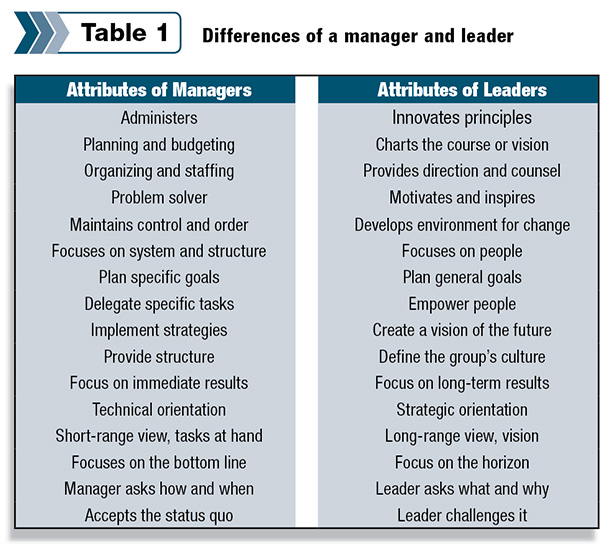Are managers leaders? Are leaders managers? This question has sparked much debate in the business world and for many years with leadership researchers, who have studied the structure and success of businesses. In agriculture, businesses – whether it be farms, ranches, feedlots or general agricultural-related companies – focus also on managers and leaders to result in success.
Similarities of leaders and managers
Our first reaction is, of course, a manager must be a leader because they are serving in a management role and this role usually brings with it supervision and power.
We often associate titles with leadership: If one is the farm or ranch manager, then we assume they are a leader.
But titles don’t always mean one is a leader – titles are more associated with the responsibility of the job. Because you are in a management role, does that automatically make you a leader?
Leadership author J.P. Kotter believes there are some similarities between managers and leaders because they both involve a decision-making process, both work with people to accomplish a goal and ensure that goal is reached, and they are both action systems.
But despite these similarities, there are differences that actually make the two very distinct. So what are the differences between a manager and a leader?
Managers
Successful businesses need solid management to keep the day-to-day functions on par. Those serving in a business manager role have a lot of responsibility on their plate and are critical to the business, team or organization.
In a ranch setting, they probably have several employees to manage, a cow herd to oversee, a supervisor to report to and a financial portfolio to manage.
In a feedlot setting, a business manager may have several middle managers they oversee, such as the head of the processing crew, the feedmill manager, the cattle buyer and the financial manager.
People are selected for management roles because of identified skills needed for a management role. Often these skills include planning, budgeting, human resource management, organization, problem solving and a track record of good performance.
They are selected for management roles to help the business reach its goals, whether that be to raise healthy, quality calves to sell each fall, manage a feedyard where there is a profitable cost of gain or oversee the development and breeding of a top-level seedstock herd.
Most often, managers provide order and consistency. They focus on producing products or services and reaching the short-term goals.
Managers are important and crucial, but they are different than leaders. To be a manager who is also a leader, additional skills and characteristics must be accomplished.
Leaders
Those who are in leadership roles and are leaders are faced with different expectations than managers. One of the main differences is: Managers take control of today; leaders focus on the future.
Leaders provide oversight to the management team because they provide the vision and the direction for the future.
They must be able to see the big picture, guide the managers and employees to move in the direction of this vision and empower all to do so.
Leaders work with people like managers do, but at a different level; they are focused on empowering people, even the managers, to produce change and to create change in behaviors.
Leaders are the people in business and organizations that might be in a CEO role or president of the company.
It is their responsibility to lead the business to the next step, take calculated risks, challenge the norm, look outside the box and make the ranch, farm or agricultural enterprise profitable and successful.
They are the ones that push the envelope to move the business forward.

To learn more about the differences of a manager and leader, study the descriptions in Table 1.
Summary
Managers and leaders serve different roles – yet essential roles. Companies need both. Competent managers and insightful leaders to chart the business in the right direction and keep day-to-day projects going smoothly.
Just imagine a business with really strong management but no leaders – how could that business move ahead? Things would be bogged down reaching day-to-day goals and bureaucracy.
A business with all leaders and no managers could chart a course that was not feasible.
Steps forward may be envisioned, but there are no managers to make them happen. Peter F. Drucker, management guru, says: “Management is doing things right; leadership is doing the right things.” ![]()

Lynn Gordon
Ag Leadership Specialist
Assistant Professor SDSU Extension and Department of Teaching, Learning and Leadership








